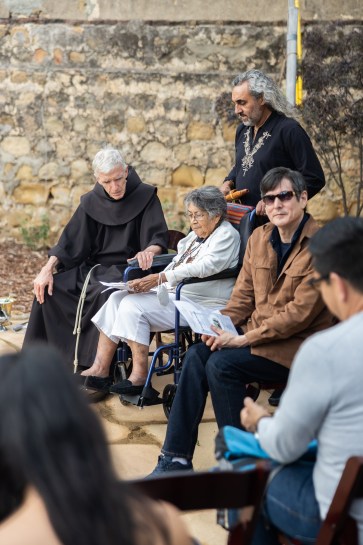Chumash Memorial Bear Sculpture Installed in Old Mission Cemetery
Ernestine Ygnacio-De Soto Among 50 Assembled to Commemorate Chumash Who Lived and Died Under Roof and Rule of Early Franciscans

According to historical documents, the deaths of about 3,800 baptized Chumash people living in Santa Barbara were recorded between the years 1789 and 1840. The bones of some lay interred in a large mass grave in the Old Mission, comingled with the remains of Spaniards, Californios, Mexicans, and Americans. This past Thursday, about 50 people — Chumash individuals from the Barbareño and the Coastal bands, Old Mission friars, historians, and assorted dignitaries — assembled by the far wall of the Old Mission cemetery lawn to dedicate a large memorial statue of a Chumash woman with her arm draped over the shoulder of a massive bear to commemorate the Chumash who lived and died under the roof and rule of the early Franciscans.

Those assembled dipped their hands into a chalice with sage-infused holy water, making the sign of the cross, and gathered up the sage smoke billowing forth from an incense miter. They also listened to Ernestine Ygnacio-De Soto recite the Lord’s Prayer in both English and Chumash. Ygnacio-De Soto’s mother, Mary Yee, was the last Santa Barbara Chumash who grew up knowing and speaking the Chumash language. Ygnacio-De Soto, who identified herself as part Barbareño Chumash and part Mexican, played a pivotal role in translating the idea of the memorial into a reality. The bear, reportedly, was her idea and signifies perseverance, courage, and leadership.
“We have to be strong and resilient in the spirit of the bear,” Ygnacio-De Soto stated. “And that’s all I have to say about it.”
Ygnacio-De Soto’s nephew James Yee — now working on his linguistics PhD at UCSB, where he teaches the Chumash language — read the names of nine Chumash killed during the revolt of 1824, during which hundreds of Chumash rose up in an organized and militarily unsuccessful uprising at three missions throughout Santa Barbara County. Yee read the names first in Spanish and then in Chumash. That recitation of names would be the most direct reference made to the harsh and complicated colonial history shared by the Chumash and the Franciscans.
Now in her eighties, Ygnacio-De Soto has long been outspoken in advocating the preservation of Chumash culture and history and has worried little about stepping on the toes of other Chumash whose lineage she doesn’t recognize as authentic or genuine. While whispers of those controversies hovered, last week’s memorial marked a cultural and personal trifecta of sorts for Ygnacio-De Soto. In January, she took to the stage of The Granada Theatre, reading the words accompanying the debut of symphonic production — in Chumash.
More recently, she was named Grand Marshal for this year’s Fiesta, a civic event that embodies and celebrates the settlers who claimed Santa Barbara after the Chumash were pushed aside either by force, disease, or assimilation. This marks the first time in the history of Fiesta that a person of Chumash descent has been named Grand Marshal.
During her remarks, Ygnacio-De Soto acknowledged the hardships endured by the Chumash over the past two centuries, terming that history “a bittersweet process.” She also expressed pride in how the memorial — for which a bronze plaque written in English and Chumash will soon be forthcoming — turned out.
“I’m happy I don’t speak Russian,” she added, alluding to the fact that Santa Barbara’s early Spanish colonizers built the missions and the presidio along much of California’s coast to keep Russian settlements from springing up, then a very real possibility.






You must be logged in to post a comment.